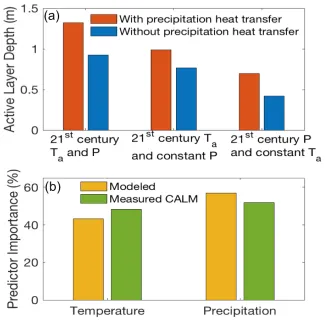Surface energy budgets of high-latitude permafrost systems are poorly represented in Earth System Models (ESMs), yet permafrost is rapidly degrading and these dynamics are critical to future carbon-climate feedback predictions. A potentially important factor in permafrost degradation neglected so far by ESMs is heat transfer from precipitation, although increases in soil temperature and thaw depth have been observed following increases in precipitation. Using observations and a mechanistic ecosystem model, ecosys, scientists at LBNL show here that increases in precipitation hasten active layer development beyond that caused by surface air warming across the North Slope of Alaska (NSA) under recent and 21st century climate (RCP8.5). Modeled active layer depth (ALD) in simulations that allow precipitation heat transfer agreed very well with observations from 28 Circumpolar Active Layer Monitoring (CALM) sites (R2=0.63; RMSE = 10 cm). Simulations that ignored precipitation heat transfer resulted in lower spatially-averaged soil temperatures and a 39 cm shallower ALD by 2100 across the NSA. The results from this sensitivity analysis show that projected increases in 21st century precipitation deepen the active layer by enhancing precipitation heat transfer and ground thermal conductivity, suggesting that precipitation is as important an environmental control on permafrost degradation as surface air temperature. These researchers conclude that ESMs that do not account for precipitation heat transfer likely underestimate ALD rates of change, and thus likely predict biased ecosystem responses.
For more information, please contact:
Zelalem Mekonnen
zmekonnen@lbl.gov

